class: center, middle, inverse, title-slide # Week 13: Terrorism ## Is terrorism effective? ### Danilo Freire ### 03 December 2019 --- <style> .remark-slide-number { position: inherit; } .remark-slide-number .progress-bar-container { position: absolute; bottom: 0; height: 6px; display: block; left: 0; right: 0; } .remark-slide-number .progress-bar { height: 100%; background-color: #EB811B; } .orange { color: #EB811B; } </style> # Last week we saw that .font150[ * Suicide terrorists might not be rational, but their leaders surely are * Suicide terrorism is an extreme example of _costly signalling_, which is used to show commitment to the cause and resolve to fight * Suicide terrorism might work, but only when it targets non-essential functions of the state * Terrorist strategies include: attrition, provocation, spoiling, intimidation, and outbidding ] --- # Last week we saw that .font140[ * People who join terrorist organisations also share some characteristics: - Feeling of anger and disenfranchisement - The perception that conventional political activity does not work - Identification with victims - Believe that the use of violence is justified - Sense of reward, material or not - Strong social ties with other members * Engineers are particularly overrepresented in Islamic terrorist groups ] --- class: inverse, center, middle # How effective is terrorism? <html><div style='float:left'></div><hr color='#EB811B' size=1px width=800px></html> --- # Why terrorism does not work .center[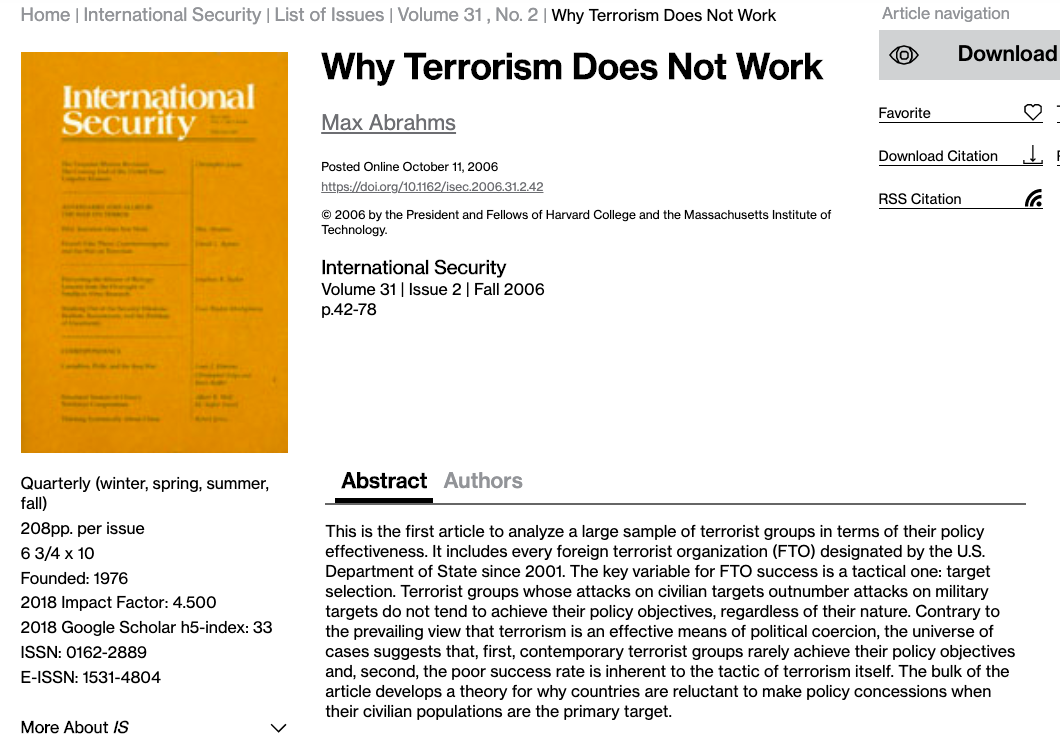] --- # Introduction .font140[ * The prevailing view in political science was that terrorism is an effective strategy * Terrorist groups are often able to gain concessions from target governments or opposition groups - First Palestinian Intifada forced the Israeli gov't to negotiate and the UN to adopt the principle of a two-state solution * If terrorism works, it is a major issue in democracies: it indicates that indiscriminate violence pays off * Moral hazard: Other groups may be tempted to use terrorist tactics too ] --- # Introduction .font150[ * Terrorism supposedly works because it increases the bargaining power of weaker groups (the terrorists) * To reiterate, the effect should be particularly pronounced in democracies: - Less likely to use violence, more likely to dialogue with the opposition, free press allows terrorists to publicise their attacks * The two readings we discussed last week affirm this is the case * _This article contests their findings_ ] --- # Measuring terrorism's effectiveness .font140[ * He claims that Kydd and Walter (2006) and Pape (2003) use a very small number of cases, and focus almost exclusively on the Hezbollah, Hamas, and the Tamil Tigers * These are not representative cases as they are some of the few that have succeeded * If you add a larger number of groups in the analysis, the results change substantially * His work includes 28 terrorist groups as classified by the US Department of State * He measures terrorism' success in terms of policy concessions from target governments ] --- # Measuring terrorism's effectiveness .center[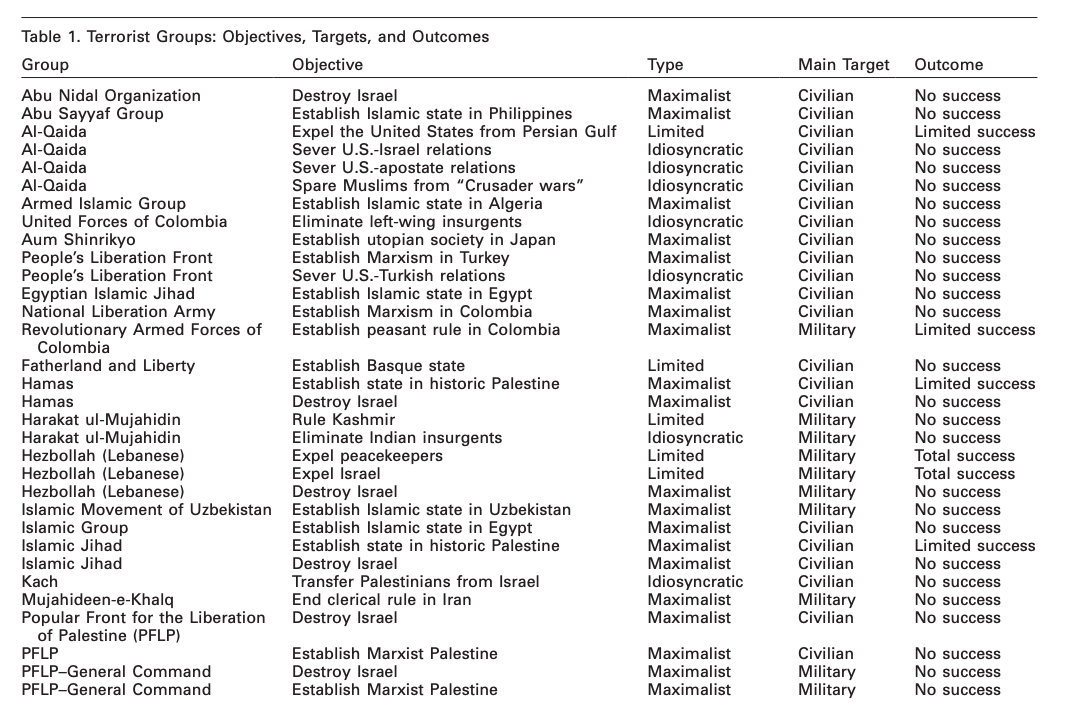] --- # Measuring terrorism's effectiveness .center[] --- # Measuring terrorism's effectiveness .font150[ * Both "total success" and "partial success" are counted as successes * Only 3 successes in 42 cases: - Hezbollah in 1984 and 2000 - Tamil Tigers from 1990 * As a comparison, economic sanctions are widely considered as policy failures although they have a rate of success of ~35% * _Terrorism doesn't pay_ ] --- # When terrorism works .font150[ * Terrorists have multiple goals, so it's tricky to evaluate their success rate * But most terrorist groups do not achieve success regardless of the goals * The best predictor of success is _target selection_ * Groups whose attacks on civilian targets outnumbered attacks on military targets systematically failed to achieve their policy objective ] --- # Limited and maximalist objectives .font150[ * Limited objectives are usually demands over territory, natural resources, or autonomy (not secession) * Maximalist objectives, in turn, refer to demands over beliefs and ideologies * How do objectives correlate with success? ] --- # Limited and maximalist objectives .center[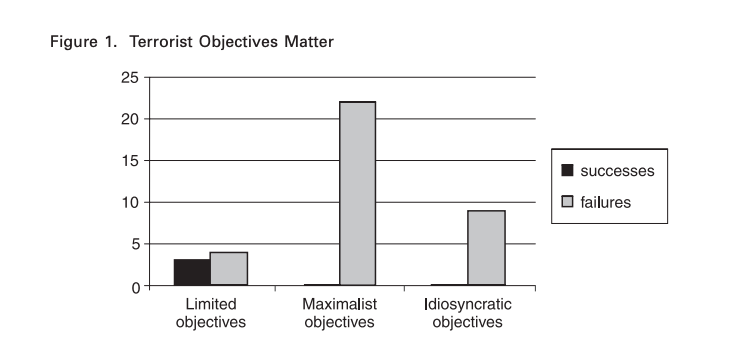] .font150[ * **Question**: if terrorist groups with maximalist objectives have so little chance of success, why do such groups still exist?] --- # Target selection .font150[ * We've just seen that different objectives lead to different outcomes * What about target selection? * Terrorists usually have two targets - Civilians - Military personnel * Does killing civilians increase the chance of policy concessions? ] --- # Target selection .center[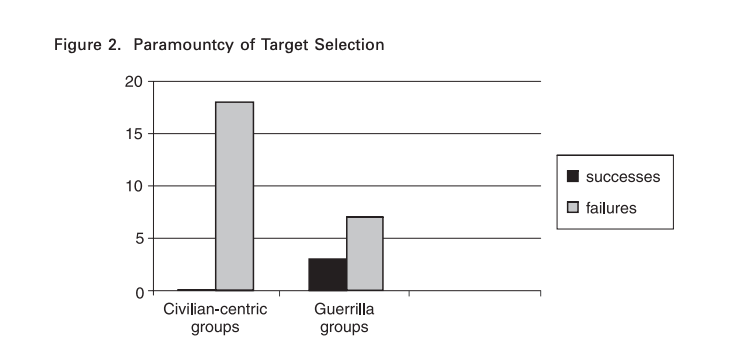] --- # Why attacking civilians is ineffective .font150[ * The author develops a theory to explain why terrorist groups do not achieve their policy objectives * Remember costly signalling and uncertainty? * His theory is based on uncertainty: - Terrorists miscommunicate their intents by being violent * States do not get the "right" signals ] --- # Why attacking civilians is ineffective .center[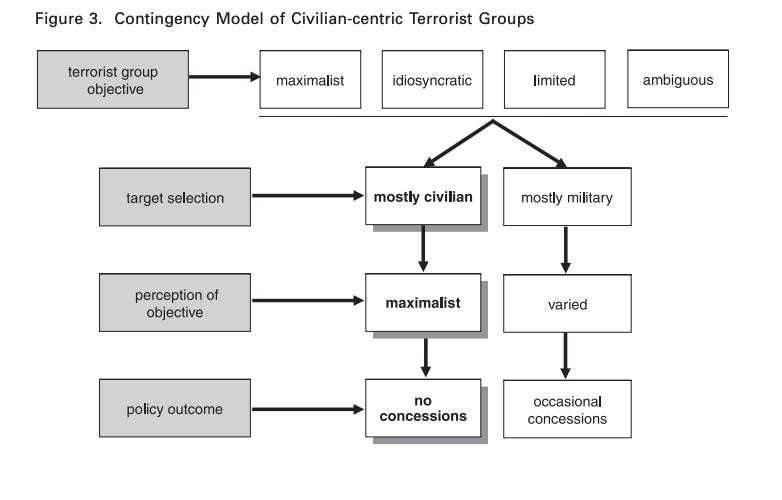] --- # Why attacking civilians is ineffective .font150[ * Assumption: _people attribute the behaviour of others to inherent characteristics of their personality—or dispositions—rather than to external or situational factors_" (p 58) * "_Attribute-effect linkage_": the objectives of the actor are presumed to be encoded in the outcome of the behaviour * Thus, the observer assumes the intentions based on what they see, not on what the senders wanted to say ] --- # States and terrorist attacks .font140[ * Since terrorism involves attacks to innocent civilians and the objectives of the group are not immediately apparent, states make inferences under uncertainty * States believe terrorists are not protesting against any type of oppression, but are interested in destroying the population _per se_ * If that is the case, almost every attack against civilians _will be understood as a reflection of maximalist goals_, that is, the existence of the state itself * As a result, states will strongly react against terrorist groups ] --- # Case study: US response to 9/11 .font150[ * The author argues that Al Qaeda provides a good example for his theory * After 9/11, the American public and authorities have focused on _the effects_ of Al Qaeda's attacks instead of analysing their _rationale_ * This has led Americans to infer that Al Qaeda wanted to destroy _the country's and economic system_, not to gain limited, plausible concessions as the group originally intended ] --- # Al Qaeda's stated objectives .font150[ * According to the author, Al Qaeda's objectives were very clear from the start: - Remove the American presence in Saudi Arabia - Stop US interventions that kill Muslims around the world - End US support for pro-Western Muslim regimes, such as Pakistan's - End US support for Israel * But these goals have not been discussed after the attacks ] --- # Effects trump rationale .font150[ * "The British journalist Robert Fisk similarly observed that after the August 1998 attacks on the US embassies in Kenya and Tanzania, US leaders emphasized the carnage and devastation, but "not in a single press statement, press conference, or interview did a US leader or diplomat explain why the enemies of America hate America" * Bush: "[Al Qaeda] hates not our policies, but our existence" * Similarly, he said that Al Qaeda wanted to curtail "our freedom of religion, our freedom of speech, our freedom to vote and assemble and disagree with each other" ] --- # Effects trump rationale .font150[ * However, the author states that _Al Qaeda never mentioned that_ * Their videos and manifestos were mute on these topics * Instead of attacking because "we [Al Qaeda] hate freedom", the attacks are a response to the fact that "you [US] spoil our security" and "attack us" * Thus, the American government inferred that Al Qaeda had maximalist goals * As a response, the "War on Terror" began ] --- # Effects trump rationale .font140[ * To be honest, the US would not be willing to fully compromise * But maybe it wouldn't have taken many steps directly against Al Qaeda's main plans - Increase support for Israel, Pakistan, and Saudi Arabia - Invade two Muslim countries - Take a more aggressive stance on terrorism worldwide * **Question**: what do you think of his reading of Al Qaeda's main goals? * What about the Russian and Israeli examples that he gives? ] --- # Does terrorism work? .center[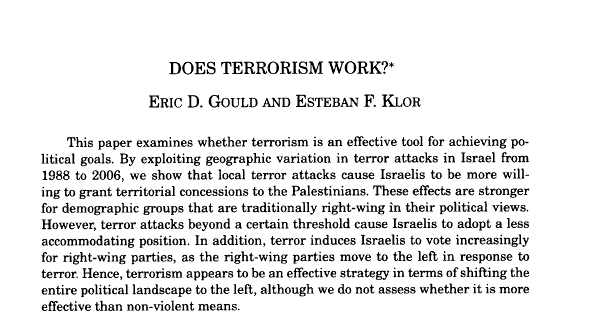] --- # Introduction .font150[ * We have just seen how states misunderstand the goals of the terrorists * How do _civilians_ see terrorist attacks? * Using individual-level data from Israel, the authors measure the effect of terrorist attacks on the propensity to make concessions and support terrorists' goals * Interestingly, terror attacks induce individuals to support right-wing parties, but it is because these parties move to the left ] --- # Introduction .font150[ * Existing evidence on how citizens react to terrorism isn't very robust * We know more about what state leaders think, as they are forced to position themselves after terrorist attacks, than what voters think about potential threats * Micro-level data is always a welcome addition to any quantitative study - It shows possible mechanisms - Provides a more compelling evidence about how people actually behave ] --- # Data .font150[ * Their sample includes several surveys fielded in Israel from 1988 until 2006 * The surveys are _not_ specifically designed to measure attitudes on terrorism * And that is probably a good thing: by asking other questions, researchers do not prime interviewees * Answers might be more spontaneous * Since the surveys have been fielded since 1969, there's a good amount of pre-treatment data to compare ] --- # Data .font150[ * The questions the authors focus on are: - Which party the voter is supporting in the upcoming elections and his or her self-described political tendency - Whether the respondent favours granting territorial concessions to the Palestinians * The survey also contains other demographic information * Let's see some descriptive statistics ] --- # Data .center[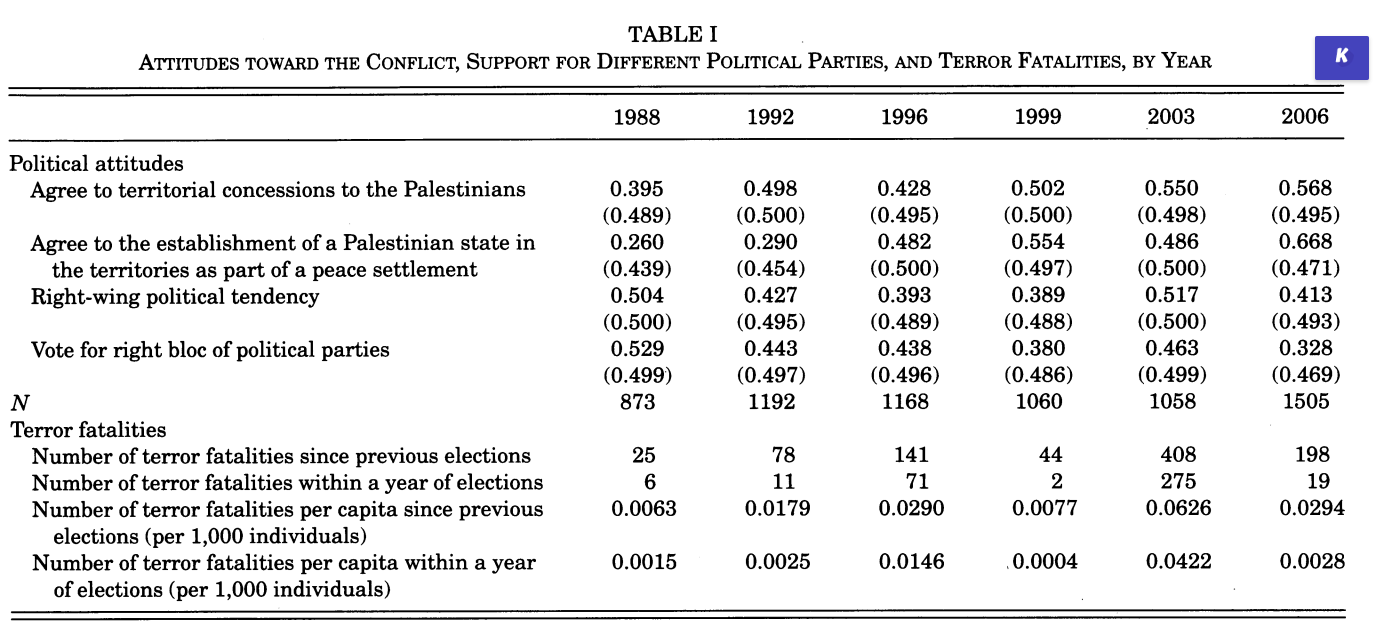] --- # Data .font150[ * Some interesting trends: * Israelis were becoming more favourable to a two-state solution * They also agreed with more territorial concessions to Palestinians * They were voting increasingly for left-wing or centre parties * Support for right bloc of political parties was decreasing ] --- # Political attitudes .center[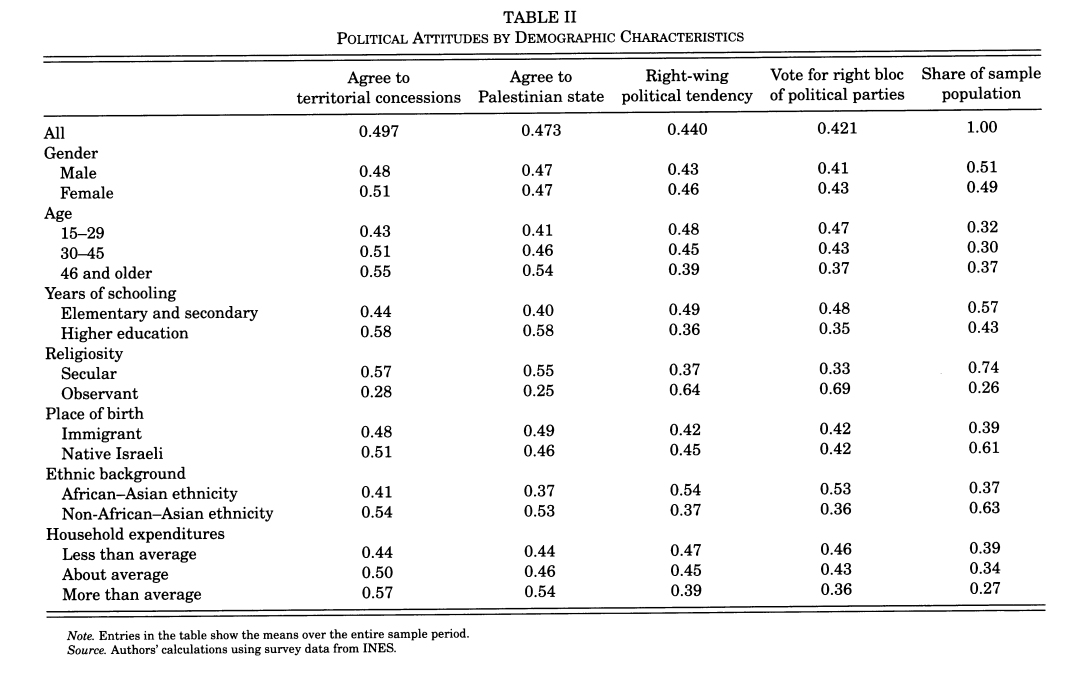] --- # Political attitudes .center[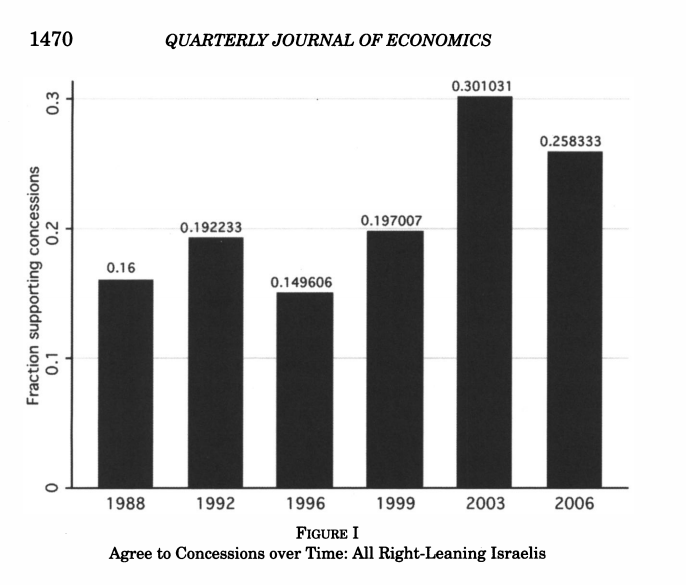] --- # Political attitudes .center[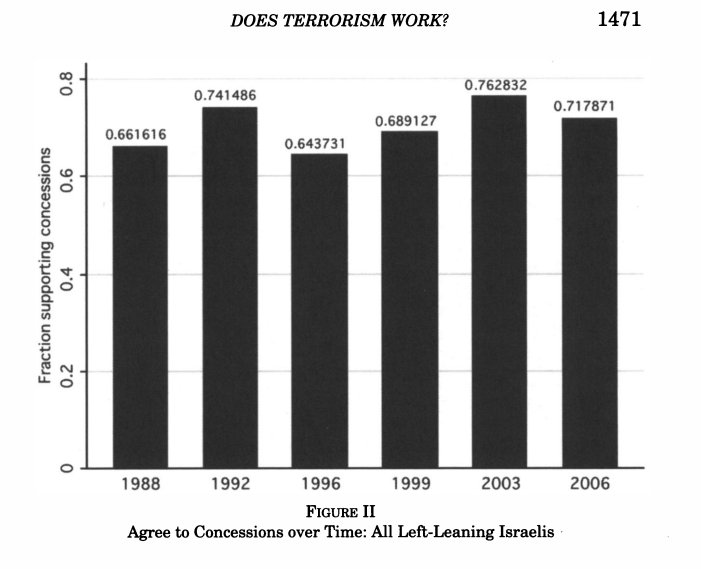] --- # Results .center[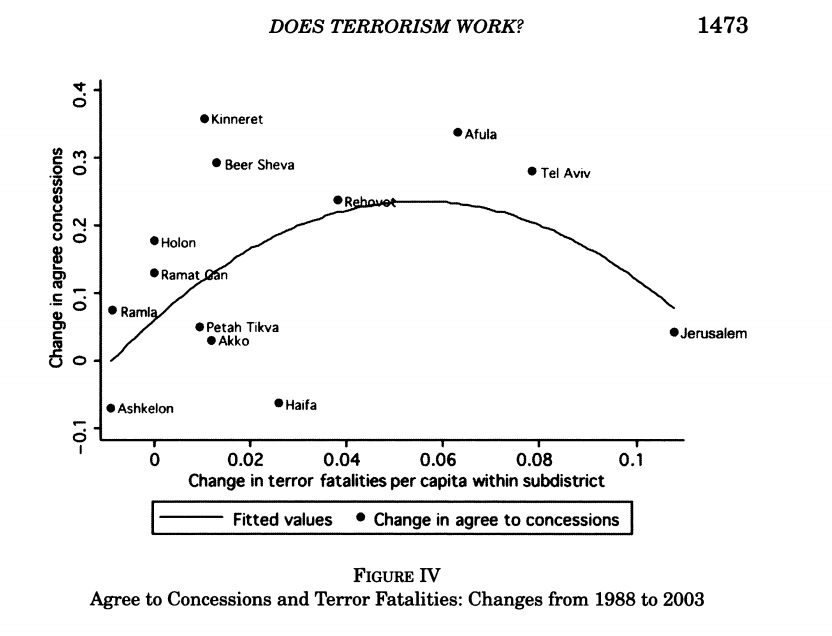] --- # Results .center[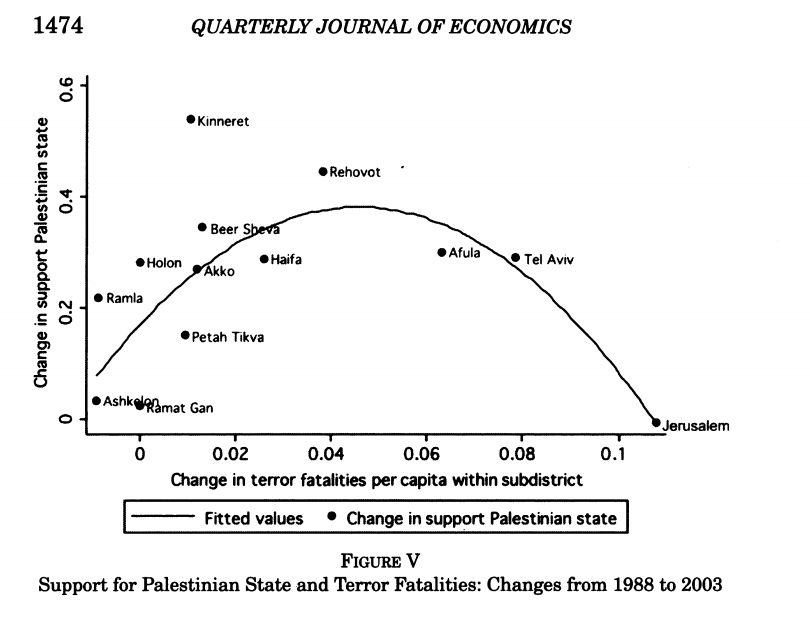] --- # Results .center[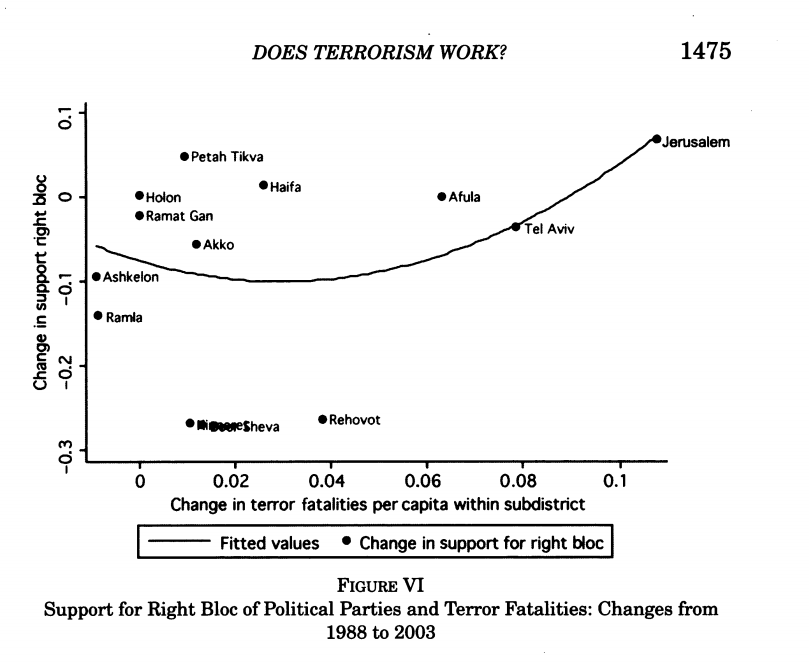] --- # Results .center[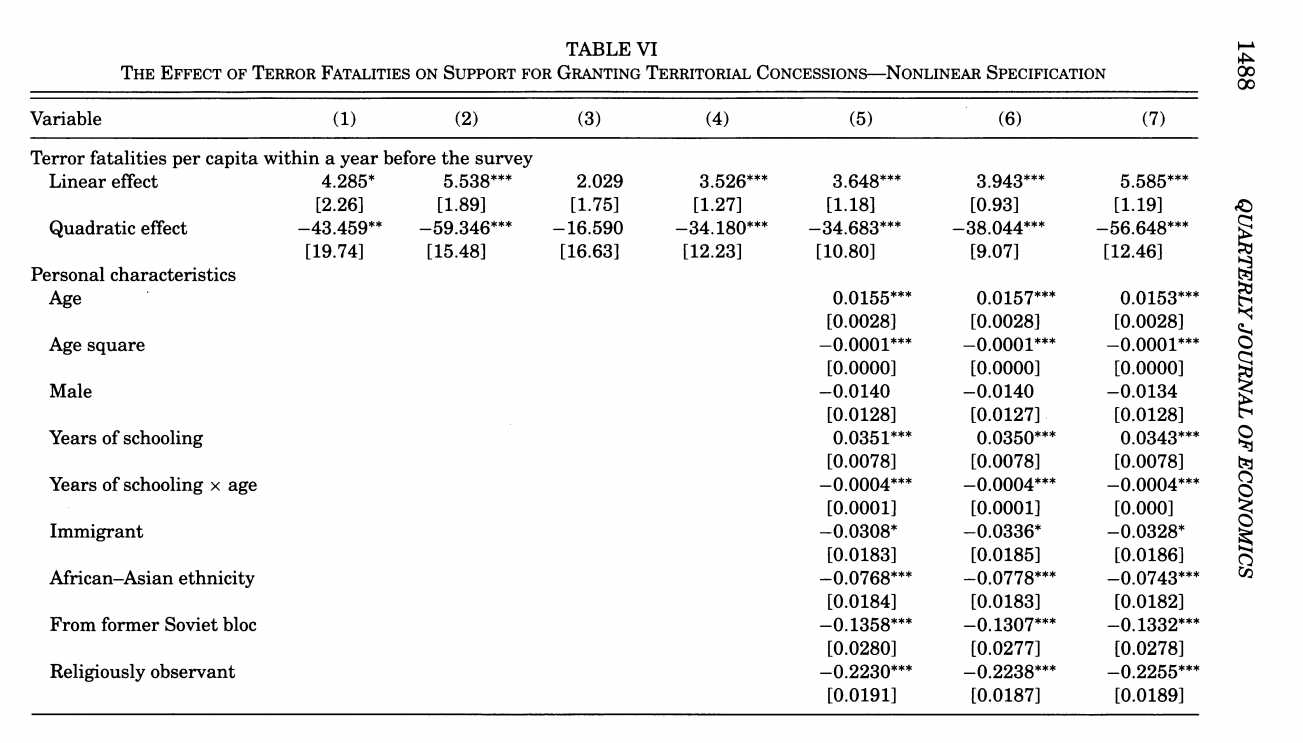] --- # Results .center[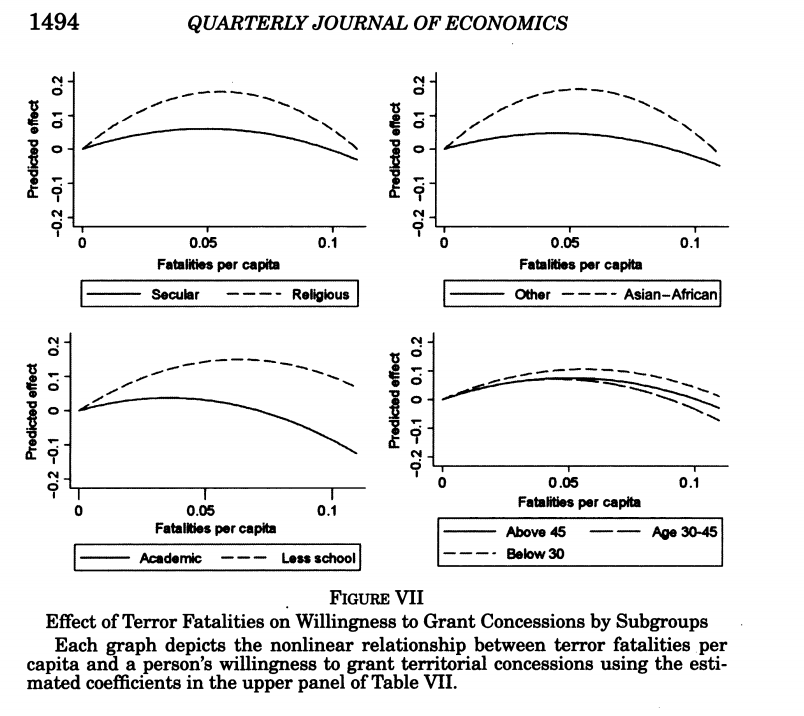] --- # Discussion .font150[ * A positive relationship between the change in fatalities per capita in a sub district and the change in the average willingness to grant concessions * However, the relationship seems to get weaker at higher levels of terror * We see our familiar inverted U-shaped line again * More terror _does_ induce more concessions, but after a certain threshold people become less likely to agree with the terrorists' demands. * _Terrorism works, but only to a certain extent_ ] --- # The effect of terror on voting .center[] --- # The effect of terror on voting .center[] --- # Discussion .font150[ * The result suggests that terrorism is leading Israelis to vote for right-wing parties * But this happens at the same time when Israelis are _less_ likely to support right-wing groups * Probably it is because the right adopted the domestic programme of the left: - The Likud was against territorial concessions in 1988, but in 2009 they were willing to do so ] --- # Discussion .font140[ * Support for right-wing parties increases amongst individuals who are male, non-native, secular, highly educated, and not from an Asian-African ethnic background population * Interestingly, terrorism leads to a more accommodating attitude particularly among individuals who are religious, less educated, and from an Asian- African backgrounds * The shift towards right-wing parties occurred within subgroups that are strongly identified with left-wing parties * Thus, the authors provide evidence that _left-wing voters started supporting right-wing parties_ ] --- # Conclusion .font150[ * Terrorism might not work because leaders see the groups' goals are maximalist * People become less likely to support policy concessions after attacks reach a certain threshold * **Question**: how can we combine both findings? ] --- # Terrorists who don't kill .center[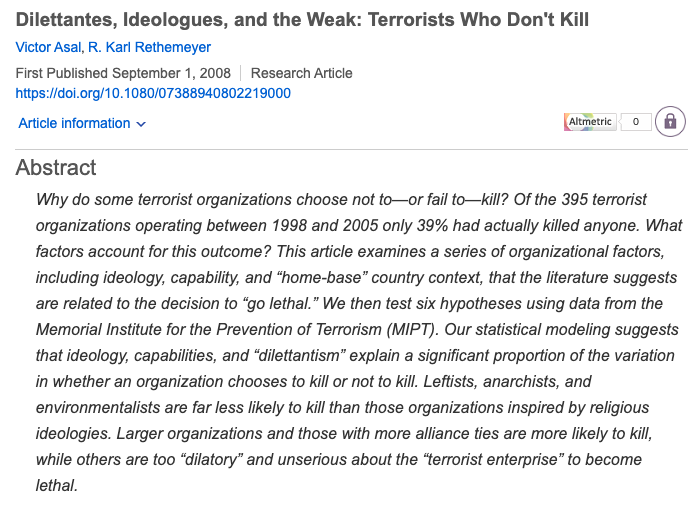] --- # Terrorists who don't kill .font150[ * When most people think of terrorism, they likely think of some form of carnage * But this is not always the case * Most terrorist groups actually _don't kill anyone_ (!) * Of the 395 groups the authors gathered information from, only 39% of them murdered someone * Thinking of our discussion of costly signalling, that doesn't make much sense * _Why don't they kill more people?_ ] --- # Terrorists who don't kill .font150[ * Some scholars argue that terrorists who don't kill are simply not terrorists * They might be aggressive or annoying, but should be classified differently * **Question**: should the KKK still be classified as terrorist if they don't kill anyone? * What is the relationship between violence and terrorism? ] -- .font150[ * Should the _threat_ of violence count as terrorism too? ] --- # Why not kill? .font140[ * Organisations use certain frames to help them interpret the world * Some of those frames are more open to violence than others * Religion is particularly potent because its adherents are attempting to address a divine audience * Yet there are religious groups that do not use violence: - Hizb ut-Tahrir doesn't use violence, although many countries don't allow them to speak openly about their views ] --- # Why not kill? .font150[ * Although there are exceptions, religious groups are more likely to use violence * 65% of Islamic organizations have killed between 1998 and 2005 * 70% of organizations that mix religion and ethnonationalism have killed over the same period * However, some other ideologies are openly against violence too... ] --- # Ecoterrorism .center[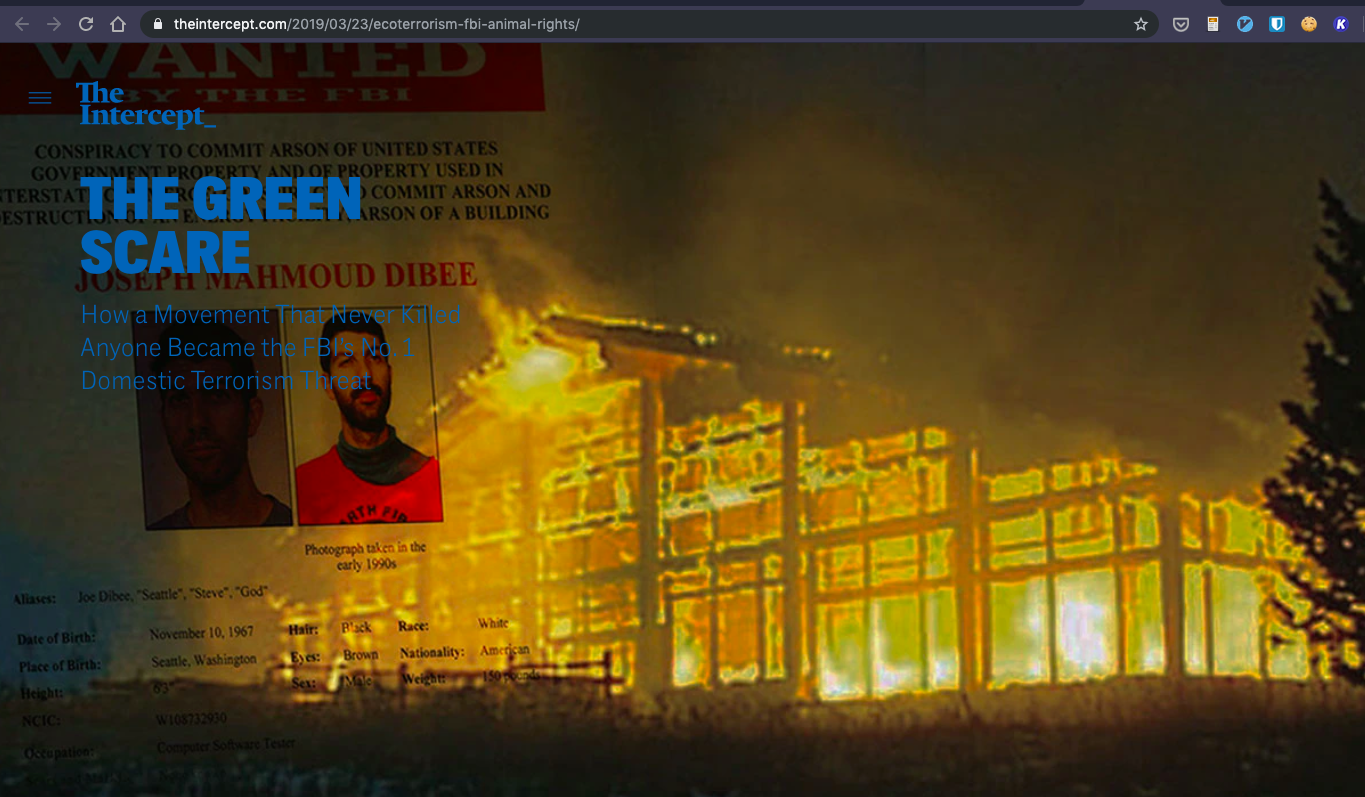] .center[<https://theintercept.com/2019/03/23/ecoterrorism-fbi-animal-rights/>] --- # Ecoterrorism .center[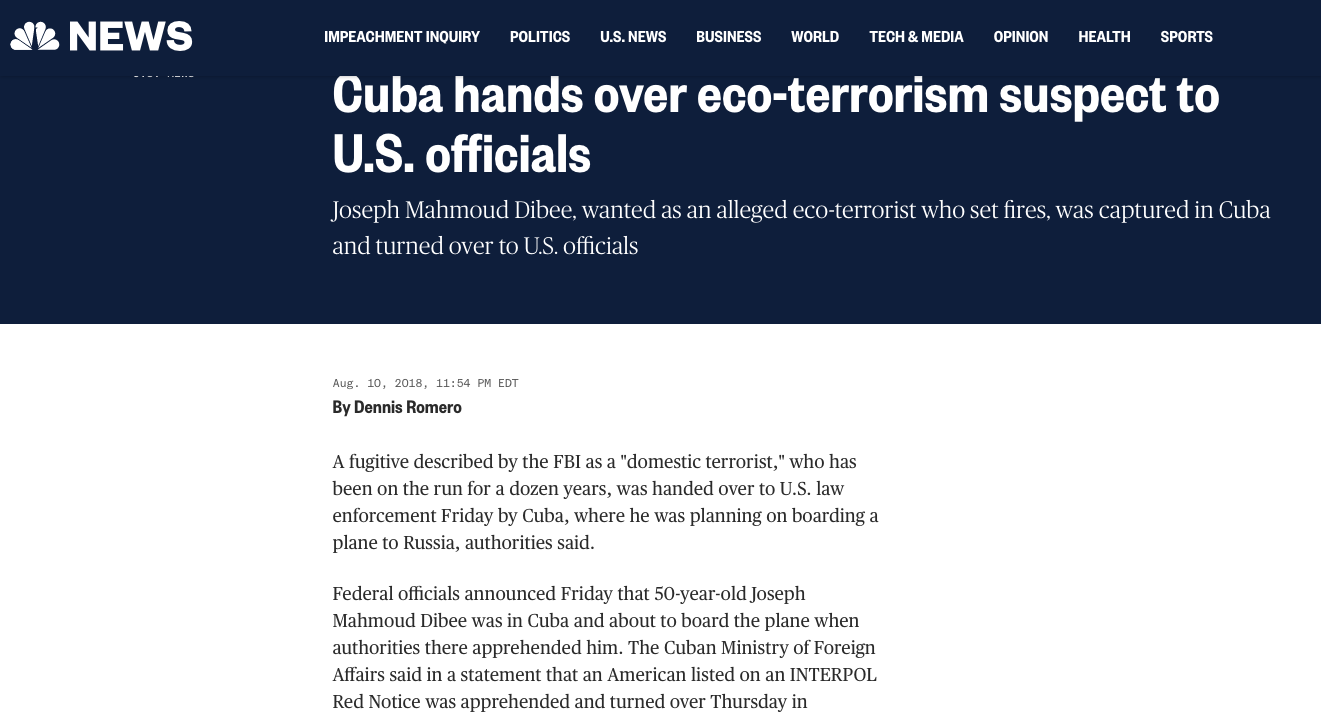] --- # Earth Liberation Front .font150[ * The ELF is a movement that defends animal rights and was founded in the UK in the early 1990s * Since 1998 they have carried dozens of attacks, mainly targeting factories * Indeed, they have rarely killed anyone * But should they be considered a terrorist group? * Which other groups are also not violent but may be classified as terrorists? ] --- # Left-wing anarchism .center[] --- # Anarcho-capitalism .center[] --- # Anarchism .font150[ * Most anarchist groups are peaceful, both from the left and from the right * It is true that Russian anarchists were some of the first terrorist groups in the world, yet many anarchists were openly against violence * Pierre-Joseph Proudhon, Henry David Thoreau, Leo Tolstoy * No clear definition of the "other": inclusive ideology * _Hypothesis 1_: Among terrorist organizations the least likely to kill are those adhering to a leftist, anarchist, or environmental ideologies ] --- # The weak and the dilettantes .font150[ * Some terrorist groups don't kill because they don't want to; * Others don't kill because _they can't_ * Smaller or young organisations may not have the capacity to kill * Terrorist groups without external support are also less lethal * Thus, "amateurish" groups don't kill that much (H2-H5) ] --- # Analysis .center[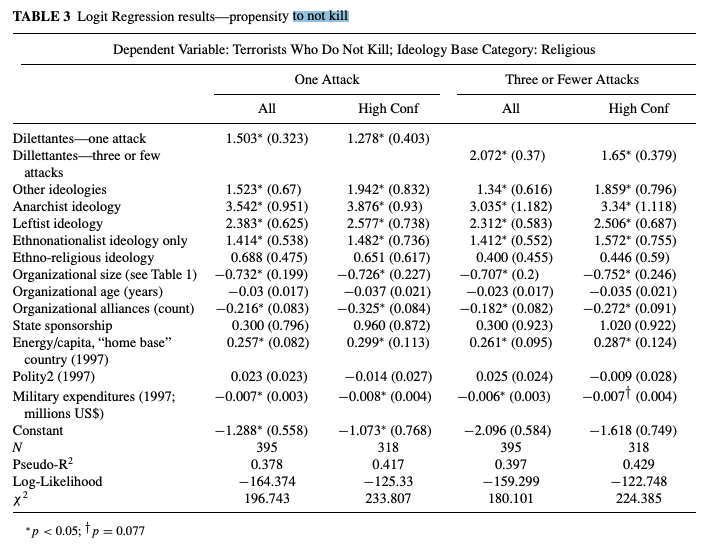] --- # Analysis .center[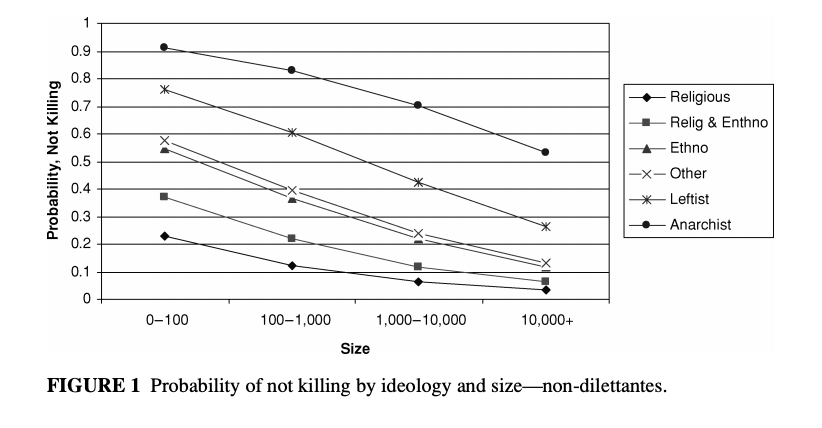] --- # Analysis .center[] --- # Discussion .font150[ * Anarchists are the least likely to kill of all ideological types * Environmentalist and animal rights activists did not kill at all during the period 1998–2005 * Ethnonationalist, leftist, and “others” are all about equally likely to kill, but all are less likely to kill than religious and ethno-religious organizations. * Religious and ethno-religious organisations are the most prone to killing ] --- # Conclusion .font150[ * Although we associate terrorism with violence, the majority of terrorist groups are unable or unwilling to kill * Small, disconnected organisations are much less likely to kill * Leftists, anarchists, environmentalists, and (to a lesser extend) ethnonationalists are less prone to violence * The result should be extended, but it helps inform counter-terrorism policies ] --- # Why civil resistance works .center[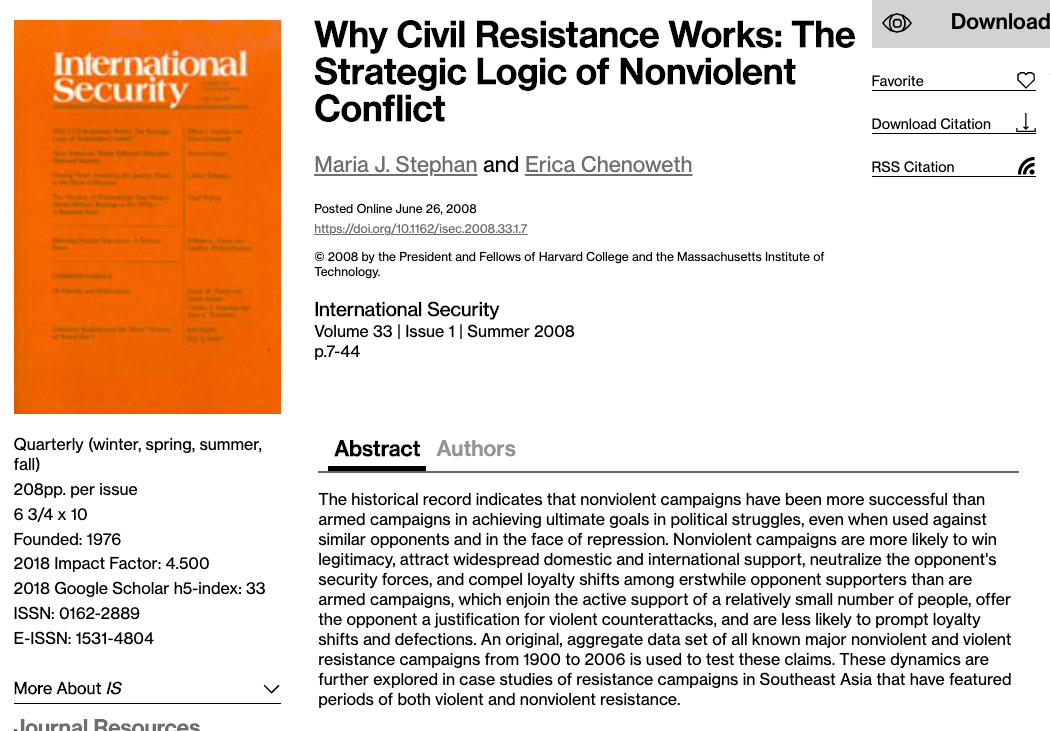] --- # Introduction .font150[ * Scholars have noted that non-violent action is effective to achieve political goals * Yet, there was no comprehensive evaluation of their _relative_ success compared to violent means such as terrorism * The authors provide the first test of the hypothesis that nonviolent campaigns are more effective than violent ones ] --- # The logic of non-violent resistance .font150[ * "Non-violent resistance is a civilian-based method used to wage conflict through social, psychological, economic, and political means without the threat or use of violence" * There many variations of civil resistance: strikes, boycotts, noncooperation, etc * It takes place outside of traditional political channels * Non-violent resistance _is not_ the same as pacifism: the vast majority of participants in non-violent struggles have not been devoted to principled nonviolence * It involves _defiance_ ] --- # The logic of non-violent resistance .font150[ * As we've just seen, terrorists do not always succeed * Non-violent campaigns have a much higher success rate * The authors argue that there are two reasons behind their success: - Backlashes against the government - Openness to negotiation ] --- # Backfire .font150[ * Violent repression against non-violent campaigns is tends to backfire * Government violence is seen as unjust * Government supporters can identify with the protesters - Mostly importantly, nonviolent action can win the support of the military * The same is true for the international community - Democractic regimes and international NGOs often support peaceful protests ] --- # Openness to compromise .font150[ * Non-violent groups are also more likely to reach an agreement with the gov't * Two reasons why: - As the groups are perceived as legitimate, it is easier for the government to negotiate with them - The groups' supporters also tend to be less radical than terrorists * Repression against violent protests can backfire too (see the IRA), but this happen less often ] --- # Hypotheses .font150[ * The authors then test a few hypotheses: * _Hypothesis 1_: The willingness of the regime to use violence will increase the likelihood for success among non-violent campaigns, but disadvantage violent campaigns. * _Hypothesis 2_: Nonviolent resistance has a relative advantage over violent resistance in producing loyalty shifts within security forces. * _Hypothesis 3_: International sanctions and overt state support for the campaign will advantage nonviolent campaigns over violent campaigns. * _Hypothesis 4_: External state support for the target regime will disadvantage both violent and nonviolent campaigns ] --- # Data and Methods .font150[ * A new dataset: [Non-violent and Violent Conflict Outcomes (NAVCO)](https://dataverse.harvard.edu/dataverse/navco) * Aggregate data on 323 violent and non-violent resistance campaigns from 1900 to 2006 * "We define a resistance campaign as a series of observable, continuous tactics in pursuit of a political objective." * They are not the same as random riots: they have beginning and end points, as well as distinct events throughout their history * Collected by using many qualitative sources ] --- # Data and Methods .font150[ * The outcomes of these campaigns are identified as "success", "limited success", or "failure" * To be designated a “success”, the campaign must have met two criteria: - its stated objective occurred within a reasonable period of time (two years) from the end of the campaign - the campaign had to have a discernible effect on the outcome * A "limited success" occurs when a campaign obtained significant concessions * "Failure" describes all the other cases ] --- # Results .center[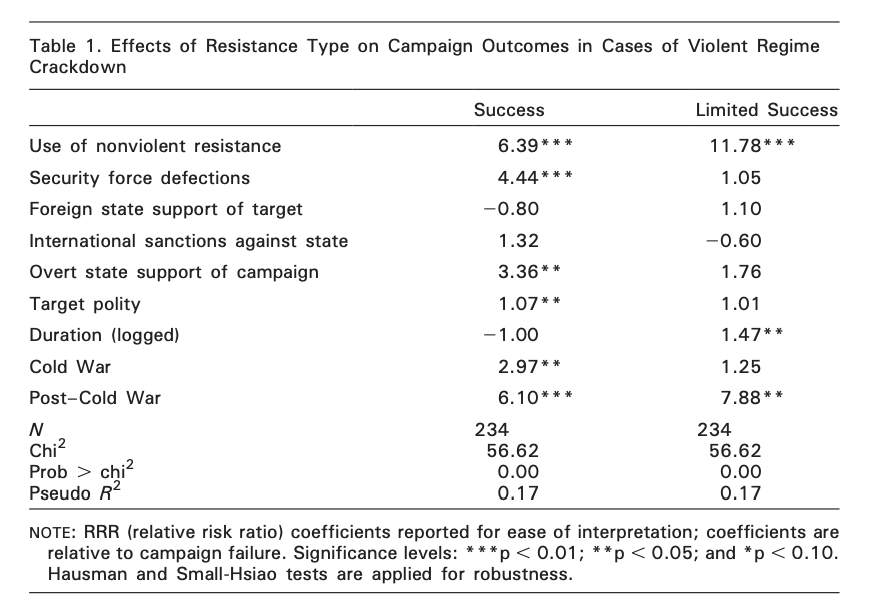] --- # Results .center[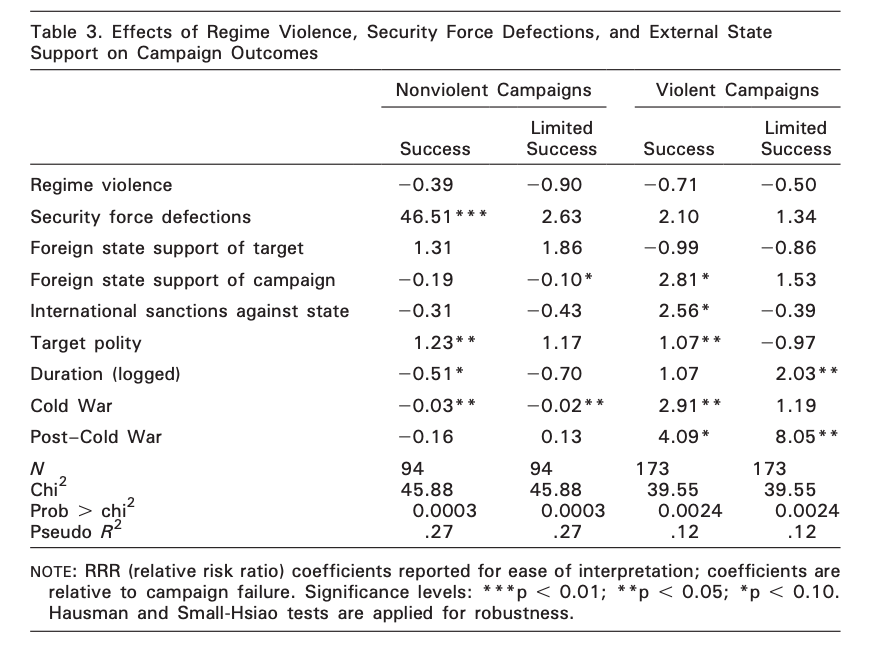] --- # Discussion .font140[ * Nonviolent campaigns are more than six times likelier to achieve full success than violent campaigns that also faced regime repression * Repressive regimes are also about twelve times likelier to grant limited concessions to nonviolent campaigns than to violent campaigns * Defections more than quadruple the chances of campaign success * Security force defections make non-violent campaigns forty-six times more likely to succeed ] --- # Discussion .font150[ * A one-unit increase in the polity score increases the chances of success for a non-violent campaign by 23 percent and for a violent campaign by about 7 percent. * The longer the campaign endures, the less likely the resistance is to achieve full success * Nonviolent campaigns occurring during the Cold War were less likely to succeed than nonviolent campaigns occurring prior to or after the Cold War * In sum, _non-violent campaigns are a more effective strategy_ ] --- # East Timor .center[] --- # East Timor .center[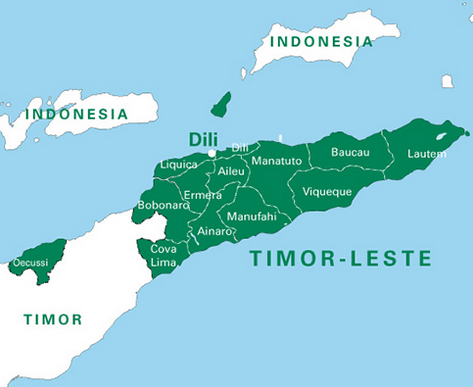] --- # Portuguese Empire .center[] --- # Suharto .center[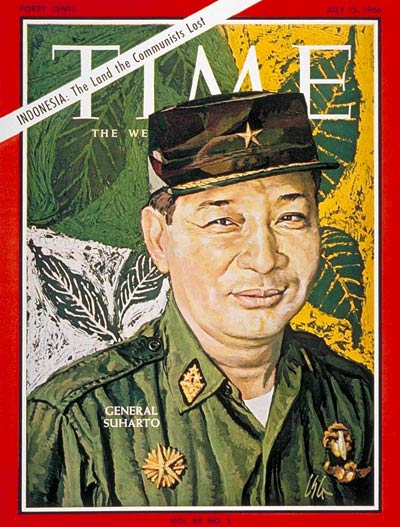] --- # FRETILIN .pull-left[] .pull-right[] --- # FRETILIN .center[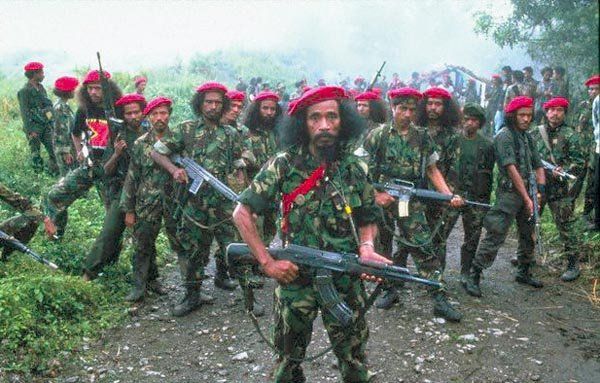] --- # Outbreak of civil war .font150[ * After annexing East Timor, Suharto gave financial incentives for about 100,000 Indonesians to move to the island * Clashes between locals and immigrants ensued * A faction of the FRETILIN decided to wage war against the government * It lost, and the Indonesian army killed 200,000 civilians * Then, the group changed its tactics ] --- # José Ramos-Horta and Xanana Gusmão .pull-left[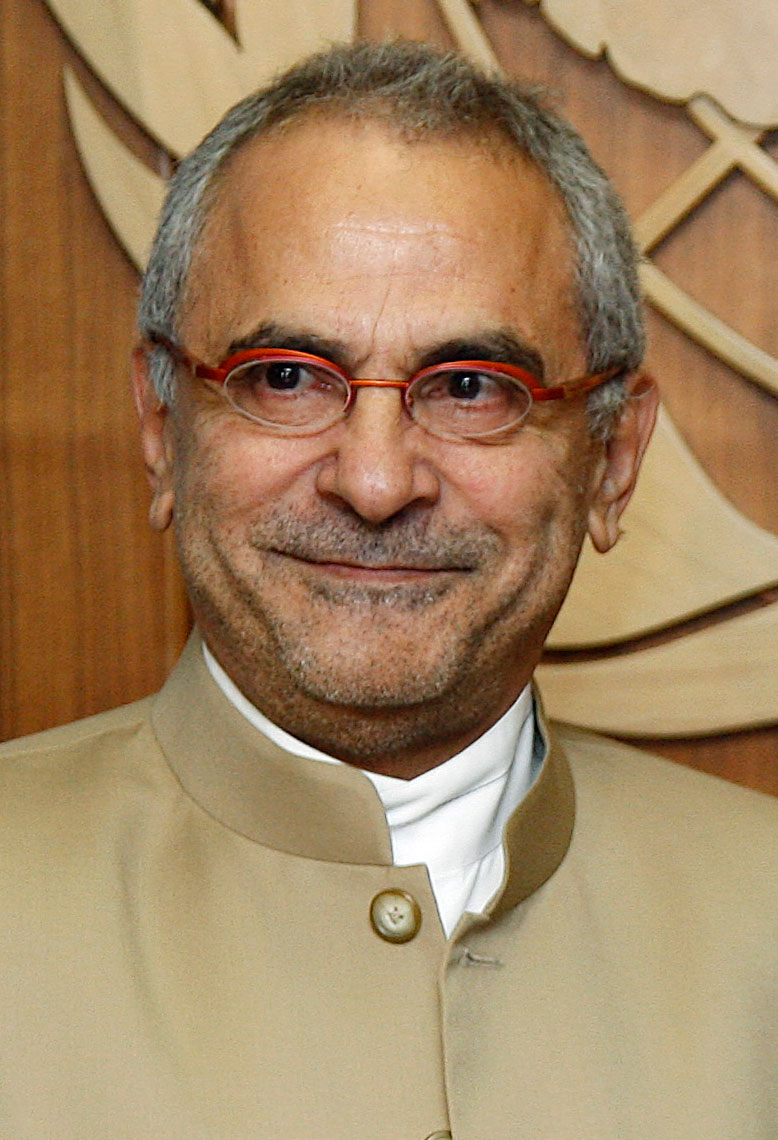] .pull-right[] --- # Non-partisan resistance .font140[ * Gusmão dropped his Marxist ideology to gain support of the Catholic church and other Western allies * Supported East Timorese students abroad to create a network of intellectuals in favour of the independence * After another attack by Suharto (1991), this time caught on the tape, the international community also increased their pressure over the Indonesian dictator * Ramos-Horta won the Nobel Peace Prize in 1996 and Suharto was eventually removed in 1998 * East Timorese called for a referendum, which the government allowed in 1999 ] --- # Non-partisan resistance .font140[ * The Timorese voted for independence, and the UN entered the country to guarantee that the result would be respected * FRETILIN's success can be attributed to their shift to non-violent resistance - A larger number of the Timorese supported their cause - The international community sympathised with their struggle - And even Indonesians criticised the responses of the regime * East Timor has been a democracy ever since, and despite still being poor, it is dealing well with its past ] --- # East Timor .center[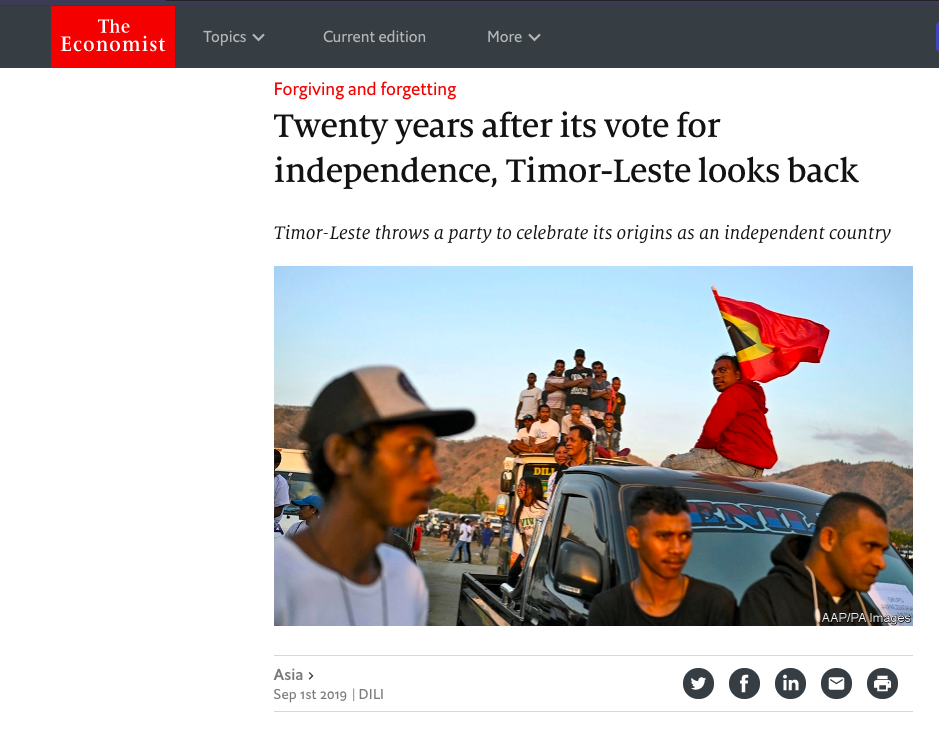] --- # East Timor .center[] --- --- class: inverse, center, middle # See you next week! <html><div style='float:left'></div><hr color='#EB811B' size=1px width=800px></html>